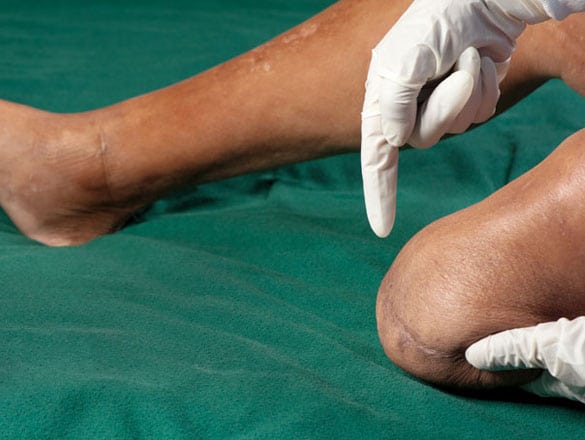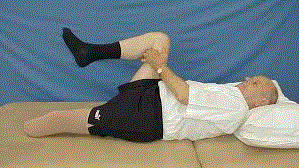nalco group
bone, muscle & joint pain physio
BOOK NOW / WHATSAPP ABOUT YOUR PAIN OR INJURY
- ORCHARD 400 Orchard Road #12-12 Singapore 238875
- TAMPINES 9 Tampines Grande #01-20 Singapore 528735
- SERANGOON 265 Serangoon Central Drive #04-269 Singapore 550265
Home > Blog > Physiotherapy & Hand Therapy > Conditions > Amputation Physiotherapy > Below-knee Amputation > Phantom Limb Pain Physiotherapy
Phantom Limb Pain Physiotherapy

When a limb (arm or leg) is amputated, patients may persistently experience a sensation that the amputated body part is still attached.
This phenomenon is called "phantom sensation."
To add to it, phantom sensation may be painful, and therefore is most often referred to as “phantom limb pain.”
Approximately 80% of
people who undergo amputations experience phantom limb pain, and
approximately 20% will experience pain for up to 2 years after the
amputation.
What is Phantom Limb Pain?
Phantom limb pain is a painful or unpleasant sensation in a body part that has been surgically amputated or traumatically lost.
This phantom limb pain sensation may occur immediately following surgery or years later.
Phantom pain is different from stump pain (or residual limb pain), which is localized in the remaining body part, or stump.
At one time, phantom pain was thought to be a psychiatric illness.
Now we understand that it occurs through complex biological mechanisms. These involve changes in your brain's perception of the affected body part, changes in how sensation is processed by your nervous system, and changes due to damage of the nerve at the amputation site.
Yes, even thought phantom limb pain can be influenced by psychiatric stress and depression, but it does not result from these conditions.
Factors associated with a higher risk of acquiring phantom limb pain include:
- Pain prior to amputation
- Pain prior to amputation of higher intensity and longer duration
- Upper-limb amputation
- Female gender
- Older age
- Residual pain in the non-amputated part of the limb
Research is incomplete regarding who will or will not experience phantom limb pain. To date, there are no clear indicators or predictors of the condition.
How Does it Feel?
Phantom limb sensation, stump pain, and phantom limb pain are common experiences following an amputation. Up to 95% of people who undergo amputation will experience at least one of these conditions.
Phantom limb sensation is a nonpainful feeling or sensation in the body part that was amputated. Phantom sensations are more commonly reported than stump pain or phantom limb pain.
The sensations feel like what the limb felt before the amputation, and are related to the same sense of awareness that helps people distinguish "myself" from others.
ie the amputated limb felt like it was before the amputation, be it painful or moving about "like normal"
The sensations occur from the interaction of current sensory inputs from your limb, and the internal "models" of the body in the brain.
- Early on, the phantom limb resembles the limb shape prior to amputation. It may be perceived in a certain position, have feelings of warmth or cold, itching, or tingling.
- Following amputation, it is common to "forget" the limb is absent and to attempt to use it—a sensation that can result in a fall.
- It is also common for people who experienced amputation to feel as though the upper portion of the limb is missing, or has shrunk. This phenomenon, called telescoping, is caused by a change in the internal model of the body in the brain. It also can cause the sensation that the amputated part of the limb is floating, or has even moved up inside the stump.
Stump pain is common in the postoperative period. It is felt only in the remaining body part, or stump. Stump pain may be felt at the incision or deeper into the residual limb.
This pain is often described as
- sharp
- burning
- stabbing or
- "electric"
Stump pain, which normally fades as the surgical scar heals, can coexist with phantom limb pain.
Phantom limb pain is a painful or unpleasant sensation in the lost body part.
Sensations can include:
- Tingling, burning, and cramping (the most common pain felt from amputation)
- Shooting, stabbing, boring, squeezing, or throbbing pain
- Pain just like that experienced at the time of the accident or serious injury
- A feeling like the phantom limb is in a forced and uncomfortable position
Since phantom pain is related to the brain and nervous system, it can also be experienced in the nonamputated part of the limb, in the opposite nonamputated limb, or even in the neck or back.
Phantom limb pain usually affects the part of the limb farthest from the body.
For example, lower-limb phantom pain will usually be experienced in the toes, heel, instep, or top of the foot. The pain may be continuous, or it may come and go during the day. In many cases it occurs randomly.
Phantom pain may be triggered by:
- Pressure on the remaining part of the limb from objects such as clothing
- Emotional stress
- Forgetting the limb’s absence and attempting to use it
- A poorly fitting artificial limb
- Stump pain
How Is It Diagnosed?
There are no medical tests to diagnose phantom limb pain.
Diagnosis is made based on your symptoms and the history of what occurred before the pain started.
For example, was there illness, trauma, or surgery before the amputation? Reporting clearly and precisely what seems to trigger the phantom pain will help your physical therapist diagnose the problem.
Our senior physiotherapists may have you complete questionnaires about your symptoms and functional difficulties to help clarify details of your problem and how it is affecting your daily life and activities. All other possible sources of your pain symptoms must be ruled out.
We will:
- Perform a careful examination of the bone and soft tissues of your stump to identify possible skin breakdown, infection, or abnormal pressure on weight-bearing contact points.
- Gently tap on the stump to identify possible nerve injury or a neuroma (an overgrowth of nerves in the stump).
- Check the fit of your prosthetic limb. (It is common for the shape of your stump to change over time, affecting the prosthetic's fit and comfort.)
- Check to make sure that you are using the correct stump socks, and that you are putting your prosthetic on properly.
- Explain how any of the above changes can cause skin breakdown and provoke pain problems.
We will work with your physician to determine the need for additional tests to rule out other conditions, such as poor circulation, and may refer you for X-rays to identify bone spurs or other abnormal bone formations.
how our senior physiotherapists and senior hand therapists can help

Phantom limb pain needs to be managed to prevent symptom flare-ups, or to resolve the problem. Pain management includes treating the biological and complex mechanisms of the problem with different strategies.
A symptom-specific approach may include—in addition to physical therapy—the use of medication prescribed by the physician, psychological and behavioral therapies, and, if needed, surgical intervention.
We may provide hands-on treatment and other interventions and exercises.
Your physiotherapy and hand therapy treatment plan may include:
Electrical stimulation
- TENS (transcutaneous electrical nerve stimulation)
- Electromyofeedback
- EMG biofeedback
Manual therapy
- Manual therapy
- Massage
- Manipulation (gentle limb movements performed by our senior hand and physical therapist)
Stump management
- Skin care
- Stump sock use
- Stump shrinker (an elastic sock to prevent swelling) use
Prosthetic fittings and proper use training
We may perform and/or refer you for proper prosthetic device fittings, and help train you in the safe usage of your prosthetic device.
Technology
Mobile applications, such as the RecogniseTM app, can help “retrain” and “remap” how the brain sends pain to a body region.
We will recommend the use of any technology that may apply to your specific condition.
Nervous system treatments
Treatment that focuses on improving how the nervous system is processing sensations from the amputated limb can help change the brain’s representation or body image of the affected part and improve nervous system function.
We may prescribe the following treatments/exercises:
- Desensitization. This treatment helps modify how sensitive an area is to factors like clothing pressure or touch.
- Graded motor imagery/movement imagery training.
These imagery exercises help your brain process information about your
amputated limb more accurately, which can help you form a clearer image
of the affected limb to improve or resolve phantom pain.
- Mirror visual feedback/mirror box therapy. This treatment uses a mirror or mirror box to "trick" your brain into believing the reflection of your nonamputated limb is actually your opposite limb. The brain adapts how it processes perception and sensation of the amputated limb, which can help reduce phantom sensations.

The above exercises should only be performed under the guidance of a trained physical therapist. For more detailed information on what these treatments involve, see the references below.
